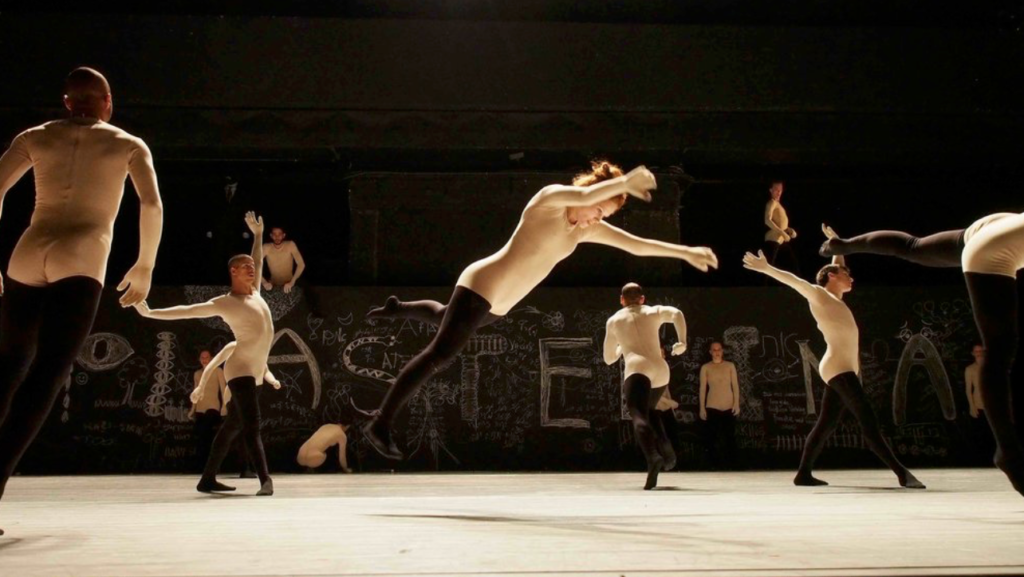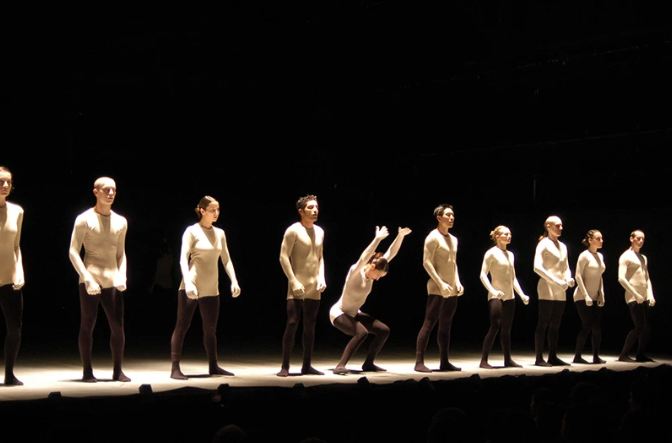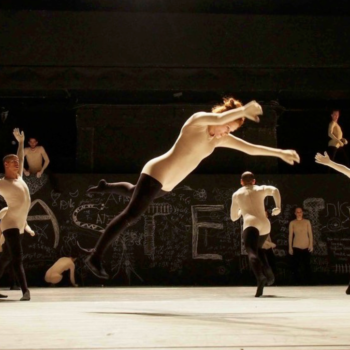Intro: When Batsheva Dance Company brought Naharin’s Virus to Brooklyn Academy of Music in spring of 2002, it seemed to explode onto the NYC dance scene. We had seen Ohad Naharin’s intriguing choreography before, but this raise his work to a different level of human ferocity. I wrote this review for the August 2002 issue of Dance Magazine, but it is not accessible online. So I am now posting it here because Batsheva — The Young Ensemble is performing Naharin’s Virus at The Joyce Theater July 10–22, 2018. It is also collected in my book, Through the Eyes of a Dancer. In my introduction to that version, I say that Ohad Naharin’s wife, Mari Kajiwara, who had been a force of nature in his work, had died of cancer in 2001. I hope you get to see Naharin’s Virus, but if you don’t, this will give you some idea of it.

Sixteen dancers line the front of the stage and stare at the audience. Each possesses a different torque, an asymmetry in the torso that gives them a slightly damaged look. One person dances in place with a fast, wrenching fury, as though trying to rid herself of a clinging nightmare. She stops, then another dancer enters into a similar fury, while all the rest are still. Then the whole row, in unison to music by Arab-Israeli Habib Alla Jamal, pound with fists on invisible walls with high-powered African-style chest contractions, and the cycle begins again. There is energy, there is unity, there is rhythm, and there is rage.
Naharin’s Virus is not the most beautiful or imaginative dance that Ohad Naharin has choreographed. But its visceral force is unforgettable. We cannot turn away from these young people of the Tel Aviv–based Batsheva Dance Company, most of whom have probably been soldiers, fighting for their survival.
One performer wearing a man’s suit, perched atop a stage-wide wall that doubles as a blackboard, recites the script of the absurdist play Offending the Audience by Peter Handke. The words wedge an insidious distrust between the performance and audience (Handke’s virus?). “No mirror is held up to you. Because we are speaking to you, your awareness increases. You become aware of the impulse to scratch yourself.” But what saves the evening from verbal overload is that, quietly he slips out of his suit and emerges wearing the same strange unitard the other dancers wear. The suit remains standing exactly where it was, without the hands and face of the dancer. This moment, repeated later, perfectly separates the dance with text from the dance with music. It provides the irony necessary to put Handke’s rebellious declarations—by turns sophomoric, contradictory, and merely clever—into perspective: the speaker is just trying something on. So, toward the end of the play, when Handke hurls insults at “us,” we are more delighted by the word play (“you bubbleheads, you atheists, you butchers, you deadbeats ”) than hurt or shocked.
The costumes make the dancers look uncomfortable, paralleling how the text makes us feel. Naharin may be hinting at the discomfort of living in a country where hostilities are so out of control. The unitards extend to cover the hands, giving the dancers unnaturally long arms, and the thigh-high black leg warmers give them short legs. In the first section, the dancers drift toward each other in small groups as though to sniff each other. Their arms hang long and they curl their hands like simian creatures, ready to scratch themselves or to grab food. Some of the couplings are also animal-like, as though lizards were mating.

Photos by Gadi Dagon
But the message on the blackboard is very human. The word “you” gets scrawled on one side, and “atem,” the Hebrew for the plural form of “you” on the other—the two languages being very separate. Kristin Francke, who begins the piece by drawing on the blackboard, drags the chalk behind her, around her elbow, echoing her tracings with her body parts, all while her body is distorted with tension. Throughout the evening, dancers go upstage to draw on the blackboard, sometimes adding a soothing sound element. Toward the end two dancers madly etch a blood-red asterisk shape that takes on a glow. Is this the source of the virus, an angry nucleus of hate? Or is it a burst of the heart’s emotion?
Occasionally a single person dances to a taped voice, presumably about that person’s life. During Inbar Nemirovsky’s solo, we hear a young woman’s voice telling us that, as a child, she liked to take off her clothes but would get punished for it. “I would get naked, and my mother would beat me. I found I liked it.” (Her mother also beat her because she questioned the existence of god.) This and other moments of dark humor contribute to the compelling strangeness of this U.S. premiere.
There are occasional leavening moments, as when a microphone is dropped down to a dancer who squeals, barks, sighs, and meets her own sounds with similarly unpredictable movements.
Naharin started out with the Martha Graham Dance Company, and what seems to have carried over is that the movement motivation comes from a deep core in the center of the body. But his style, he has said, owes more to Pina Bausch and American experimentalists like Gina Buntz. Therefore, the Batsheva, which was formed by Martha Graham and Bathesbe de Rothschild in 1964, went through an overhaul in both choreography and dancers when Naharin took over as artistic director in 1990. His repertoire for the company includes funny, joyous works as well as difficult ones.
Naharin’s Virus is infectious, but not everyone will respond to it. The experience is comparable to reading Dostoyevsky’s Notes from the Underground, with its fevered self-questioning, or seeing the work of German painter Anselm Keifer, which leads one into a depth and complexity rare for an American artist. If you have gone to that well of darkness, the experience is familiar and even satisfying. If not, it can be frightening—or offending. But there is something vital and bracing about artists who delve into difficult areas, into the darkness of our souls. Artists like these possess an undeniable courage, and this is the virus of the title, for the Batsheva dancers have caught Naharin’s courage.
¶¶¶
Featured Leave a comment
